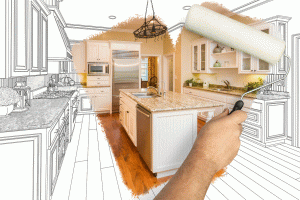
Kitchen Renovation Guide: What You Need To Know Before Remodelling Your Kitchen
A properly executed kitchen remodel is one of the best ways to boost the value of your home.
Your Kitchen Renovation Guide

A properly executed kitchen remodel is one of the best ways to boost the value of your home.
The latest kitchen design trends focus on a shift towards sustainability, smart technology, and bold aesthetics. Eco-friendly materials and energy-efficient appliances are popular. Smart kitchens feature IoT-integrated appliances for seamless operation. Bold colors, mixed metals, and two-tone cabinets add visual interest. Open shelving and large, multi-functional islands enhance functionality. Integrated, hidden appliances and minimalist designs create a clean, uncluttered look. Natural materials like wood and stone offer a timeless appeal, while statement lighting and full-height backsplashes add drama. Personalized touches and ergonomic layouts ensure kitchens are both stylish and practical, meeting modern needs with a unique, customized feel.
To choose the right kitchen layout, consider your space, workflow, and needs. The kitchen work triangle (sink, stove, refrigerator) should be efficient. Popular layouts include a U-shape for ample storage and workspace, L-shaped for open flow, galley for small spaces, and island layouts for additional prep area and seating. Ensure the layout suits your cooking habits and lifestyle, allowing for smooth movement and accessibility. Tailor the design to your specific requirements, balancing functionality with aesthetics to create a practical and inviting kitchen.
For countertops, quartz is durable and low-maintenance, granite offers natural beauty, and butcher block provides a warm, rustic feel (however some regular maintenance is required). Choose materials based on your style, budget, and maintenance preferences to ensure a functional and stylish kitchen.
Solid wood is classic and long-lasting, MDF is a budget-friendly option with a smooth finish, and plywood is strong and stable. Choose materials based on your style, budget, and maintenance preferences to ensure a functional and stylish kitchen.
Hardwood is timeless and adds value, tiles are durable and easy to clean, and luxury vinyl is cost-effective and water-resistant. Choose materials based on your style, budget, and maintenance preferences to ensure a functional and stylish kitchen.
Maximize a small kitchen by incorporating lots of storage and functionality. Use vertical space with tall cabinets and open shelving. Choose compact, multi-functional appliances. Install pull-out shelves, organizers, and corner storage units to maximize cabinet space. Opt for a light color palette to create an open feel. Utilize a small island or cart for additional prep space and storage. Incorporate under-cabinet lighting to brighten the area. Keep the design simple and clutter-free to enhance the sense of space and efficiency.
The cost of a kitchen renovation can be impacted by a number of factors, including the size of the kitchen, the quality of materials and appliances, the complexity of the design, labor costs, and the need for plumbing or electrical upgrades. Additionally, geographic location, the choice between custom or prefabricated cabinets, flooring type, and finishes can impact the overall cost.
Unexpected issues, such as structural problems, pre-existing leaks or code compliance, can also increase the cost. It is therefore important to ensure that you have a contingency budget of 10% to allow for any unforeseen budget blowouts.
Consider keeping the existing layout to avoid costly plumbing and electrical changes. Opt for budget-friendly materials and finishes, such as laminate countertops and vinyl flooring. Refacing or repainting cabinets instead of replacing them can also cut costs significantly.
Shop for discounts on appliances and fixtures. Also keep an eye on Facebook Marketplace and Gumtree for unused or leftover items from other renovations. Consider doing some of the work yourself if you have the skills (and patience). Additionally, prioritize essential updates and consider phasing the renovation to spread out expenses.
Start by seeking recommendations from friends, family, or online reviews. Verify the contractor’s licenses, insurance, and credentials. Request and compare multiple quotes (minimum 3), ensuring they cover all aspects of the project. Check their portfolio for similar projects and ask for references to assess their work quality and reliability. Schedule interviews to discuss your vision (get out that mood board), timeline, and budget. Ensure clear communication and a written contract detailing the scope of work, payment schedule, and warranties.
A typical kitchen renovation timeline can vary based on the project’s scope, but it generally follows these phases:
Overall, a kitchen renovation can take anywhere from 6 to 12 weeks or more, depending on complexity and unforeseen delays.
Expect noise, dust, and disruption, but this phase is crucial for a successful renovation. Prepare yourself by following these steps: